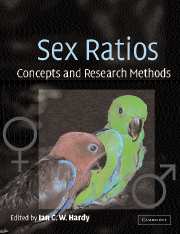Book contents
- Frontmatter
- Contents
- List of contributors
- Preface and acknowledgements
- Part 1 Sex ratio theory
- Part 2 Statistical analysis of sex ratio data
- Part 3 Genetics of sex ratio and sex determination
- Part 4 Animal sex ratios under different life-histories
- Chapter 10 Sex ratios of parasitic Hymenoptera with unusual life-histories
- Chapter 11 Sex ratio control in arrhenotokous and pseudo-arrhenotokous mites
- Chapter 12 Aphid sex ratios
- Chapter 13 Sex ratios in birds and mammals: can the hypotheses be disentangled?
- Chapter 14 Human sex ratios: adaptations and mechanisms, problems and prospects
- Part 5 Sex ratios in plants and protozoa
- Part 6 Applications of sex ratios
- Index
- References
Chapter 10 - Sex ratios of parasitic Hymenoptera with unusual life-histories
Published online by Cambridge University Press: 06 August 2009
- Frontmatter
- Contents
- List of contributors
- Preface and acknowledgements
- Part 1 Sex ratio theory
- Part 2 Statistical analysis of sex ratio data
- Part 3 Genetics of sex ratio and sex determination
- Part 4 Animal sex ratios under different life-histories
- Chapter 10 Sex ratios of parasitic Hymenoptera with unusual life-histories
- Chapter 11 Sex ratio control in arrhenotokous and pseudo-arrhenotokous mites
- Chapter 12 Aphid sex ratios
- Chapter 13 Sex ratios in birds and mammals: can the hypotheses be disentangled?
- Chapter 14 Human sex ratios: adaptations and mechanisms, problems and prospects
- Part 5 Sex ratios in plants and protozoa
- Part 6 Applications of sex ratios
- Index
- References
Summary
Summary
Hymenopteran parasitoids have proven to be exceptionally good organisms with which to test sex-allocation theory because their sex allocation is extremely labile. Sex allocation is frequently under maternal control,allowing mothers to adjust sex-allocation decisions in response to a variety of environmental conditions. Species with unusual life-histories can provide unique tests of sex-allocation theory either because maternal control over sex-allocation decisions is reduced relative to offspring control, or because the costs of producing male and female offspring differ. We consider three groups of parasitoids that are atypical in some aspect of their life-history: (1) polyembryonic species, which are unusual in that offspring may control the final sex ratio and clutch size; (2) heteronomous species, in which the sexes are generally placed in different hosts; and the balance between egg and host limitation may influence sex allocation; and (3) single-sex brood producing species, in which host versus egg limitation also influences sex ratios and which provide insight into the role of kin selection in the evolution of clutch size and sex ratios. We argue that these groups provide invaluable insights into sex-allocation behaviour by challenging the framework with which we interpret sex ratios of more typical parasitoids.
‘Usual’ life-histories, and the exception
Parasitic wasps have been favoured organisms for the study of sex ratios precisely because they are considered by many to have unusual life-histories. Indeed, observations of sex-allocation patterns in parasitic Hymenoptera have contributed greatly to the development of sex ratio theory (e.g. effects of local mate competition, Hamilton 1967; effects of spatial variation in resource quality, Charnov 1979, Charnov et al. 1981).
- Type
- Chapter
- Information
- Sex RatiosConcepts and Research Methods, pp. 218 - 234Publisher: Cambridge University PressPrint publication year: 2002
References
- 17
- Cited by



